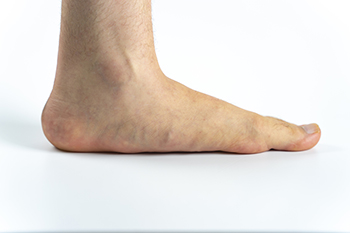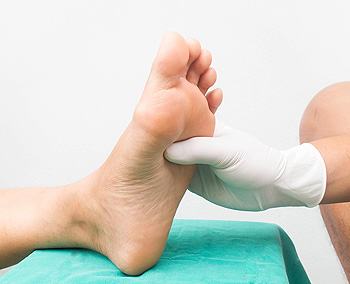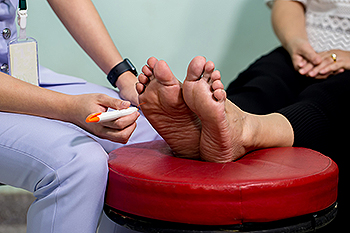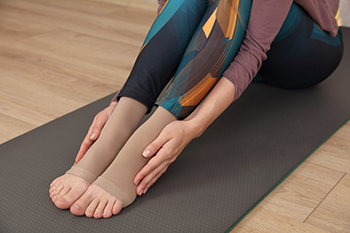

If you have flat feet and want to wear high heels periodically, there should be no problem if you do not have underlying medical conditions and if doing so does not cause you pain. Flat feet, referred to as pes planus, is when the entire surface of the foot is in contact with the ground when standing. Flat feet can be flexible or rigid. A flexible flat foot looks flat when standing. A rigid flat foot is when the arch is absent whether the foot is bearing weight or not. Flat feet are generally caused by genetics, however, injuries, muscle weakness, foot bone deformities, pregnancy, being overweight, and pre-existing health conditions can also cause flat feet. Wearing high heels is difficult especially for those with flat feet. To bolster comfort with occasional high heel wearing, make sure the heels are the proper size, opt for thicker heels, which will help with balance and strain issues, and choose shoes with platforms under three inches. Arch support shoe inserts or silicone gel pads can offer some support in cushioning and comfort. Frequently kick off the heels to take breaks and stretch legs, ankles, and feet. Try putting together a supply rescue bag of tricks, including a flat, foldable shoe, anti-blister cream for sore feet and toes, and plasters for broken or damaged toenails. If you have flat feet, want to wear heels for a special outing and you have pain in your feet before or after doing so, consult with a podiatrist who can help diagnose the problem and provide suggestions and treatment.
Flatfoot is a condition many people suffer from. If you have flat feet, contact Dr. Larry Cohen from New York City. Our doctor will treat your foot and ankle needs.
What Are Flat Feet?
Flatfoot is a condition in which the arch of the foot is depressed and the sole of the foot is almost completely in contact with the ground. About 20-30% of the population generally has flat feet because their arches never formed during growth.
Conditions & Problems:
Having flat feet makes it difficult to run or walk because of the stress placed on the ankles.
Alignment – The general alignment of your legs can be disrupted, because the ankles move inward which can cause major discomfort.
Knees – If you have complications with your knees, flat feet can be a contributor to arthritis in that area.
Symptoms
Treatment
If you are experiencing pain and stress on the foot you may weaken the posterior tibial tendon, which runs around the inside of the ankle.
If you have any questions please feel free to contact our offices located in Midtown, Manhattan New York, NY . We offer the newest diagnostic and treatment technologies for all your foot and ankle needs.

Of the many afflictions that can affect the feet, neuropathy is perhaps the most insidious and deceptive. Neuropathy can occur in the feet when the nerves are so badly damaged you might not feel pain when something is wrong with your foot and you may also feel that something is causing pain when nothing is. This nerve damage can occur from an injury, illness, infection, or other cause. Any range of symptoms can be felt because there is a spectrum of different nerves that may be affected. However, there are some self-care tricks that you can utilize for your neuropathy if it is not very severe. For example, you might try soaking your feet in a foot bath filled with chamomile or nettle leaves. These leaves are rich in antioxidants and aid in the pain relief of muscles and joints. It is beneficial to soak in this foot bath for approximately 30 minutes. Additionally, you might try giving yourself a massage or asking a friend to massage the affected areas. The purpose is to promote blood circulation. Lastly, you might consider applying an ice pack to the affected area for short intervals of time about twice a day. These are just some of the many different self-care tricks you might use for your neuropathy. It is always best, however, to consult a podiatrist about your condition.
Neuropathy
Neuropathy can be a potentially serious condition, especially if it is left undiagnosed. If you have any concerns that you may be experiencing nerve loss in your feet, consult with Dr. Larry Cohen from New York City. Our doctor will assess your condition and provide you with quality foot and ankle treatment for neuropathy.
What Is Neuropathy?
Neuropathy is a condition that leads to damage to the nerves in the body. Peripheral neuropathy, or neuropathy that affects your peripheral nervous system, usually occurs in the feet. Neuropathy can be triggered by a number of different causes. Such causes include diabetes, infections, cancers, disorders, and toxic substances.
Symptoms of Neuropathy Include:
Those with diabetes are at serious risk due to being unable to feel an ulcer on their feet. Diabetics usually also suffer from poor blood circulation. This can lead to the wound not healing, infections occurring, and the limb may have to be amputated.
Treatment
To treat neuropathy in the foot, podiatrists will first diagnose the cause of the neuropathy. Figuring out the underlying cause of the neuropathy will allow the podiatrist to prescribe the best treatment, whether it be caused by diabetes, toxic substance exposure, infection, etc. If the nerve has not died, then it’s possible that sensation may be able to return to the foot.
Pain medication may be issued for pain. Electrical nerve stimulation can be used to stimulate nerves. If the neuropathy is caused from pressure on the nerves, then surgery may be necessary.
If you have any questions, please feel free to contact our offices located in Midtown, Manhattan New York, NY . We offer the newest diagnostic and treatment technologies for all your foot care needs.

People who have diabetes are aware of the complications that can arise if proper foot care is not provided. Neuropathy, a condition that prevents feeling in the feet, may accompany diabetes. It is beneficial to check the bottom of the feet for existing cuts, bruises, or scrapes. Many patients ask a family member to help them look for cuts on the feet, or it may be done by using a mirror. Foot ulcers can be a common side effect of diabetes, and amputation may be necessary if ulcers are not treated promptly. The skin on the feet may change color in diabetic patients, and unusual sensations in the feet may be a symptom of nerve damage. Proper foot care starts with washing the feet regularly, trimming the toenails correctly, and wearing shoes that fit properly. Additionally, it can help to wear socks that are made of a cotton material, and it is beneficial to avoid activities that can injure the feet. When frequent foot exams are performed, the chances of noticing a cut is improved. Then treatment can begin in a timely fashion. If you are a diabetic patient, it is strongly advised that you are under the care of a podiatrist who can help you to manage this condition.
Diabetic foot care is important in preventing foot ailments such as ulcers. If you are suffering from diabetes or have any other concerns about your feet, contact Dr. Larry Cohen from New York City. Our doctor can provide the care you need to keep you pain-free and on your feet.
Diabetic Foot Care
Diabetes affects millions of people every year. The condition can damage blood vessels in many parts of the body, especially the feet. Because of this, taking care of your feet is essential if you have diabetes, and having a podiatrist help monitor your foot health is highly recommended.
The Importance of Caring for Your Feet
Patients with diabetes should have their doctor monitor their blood levels, as blood sugar levels play such a huge role in diabetic care. Monitoring these levels on a regular basis is highly advised.
It is always best to inform your healthcare professional of any concerns you may have regarding your feet, especially for diabetic patients. Early treatment and routine foot examinations are keys to maintaining proper health, especially because severe complications can arise if proper treatment is not applied.
If you have any questions please feel free to contact our offices located in Midtown, Manhattan New York, NY . We offer the newest diagnostic and treatment technologies for all your foot and ankle needs.

Poor circulation is a serious ailment that has several symptoms. It occurs when blood flow is restricted and can happen for various reasons. One of these is diabetes, as a result of elevated blood sugar levels. Nerve damage may result, the feet can have a tingling sensation, and they may lose feeling completely. Additional reasons include a possible blood clot, which may block blood flow. Patients who smoke may be at an increased risk for poor circulation, which can aid in damaging the blood vessels. Symptoms associated with poor circulation include cold extremities, swollen feet, and poor digestion. Normal blood flow is crucial in having proper digestion, and symptoms of this include abdominal pain, diarrhea, or cramping. Poor circulation for any reason is not to be taken lightly, and the feet can be negatively affected. It is suggested that you are under the care of a podiatrist who can treat poor circulation.
While poor circulation itself isn’t a condition; it is a symptom of another underlying health condition you may have. If you have any concerns with poor circulation in your feet contact Dr. Larry Cohen of New York City. Our doctor will treat your foot and ankle needs.
Poor Circulation in the Feet
Peripheral artery disease (PAD) can potentially lead to poor circulation in the lower extremities. PAD is a condition that causes the blood vessels and arteries to narrow. In a linked condition called atherosclerosis, the arteries stiffen up due to a buildup of plaque in the arteries and blood vessels. These two conditions can cause a decrease in the amount of blood that flows to your extremities, therefore resulting in pain.
Symptoms
Some of the most common symptoms of poor circulation are:
Treatment for poor circulation often depends on the underlying condition that causes it. Methods for treatment may include insulin for diabetes, special exercise programs, surgery for varicose veins, or compression socks for swollen legs.
As always, see a podiatrist as he or she will assist in finding a regimen that suits you. A podiatrist can also prescribe you any needed medication.
If you have any questions, please feel free to contact our offices located in Midtown, Manhattan New York, NY . We offer the newest diagnostic and treatment technologies for all your foot care needs.